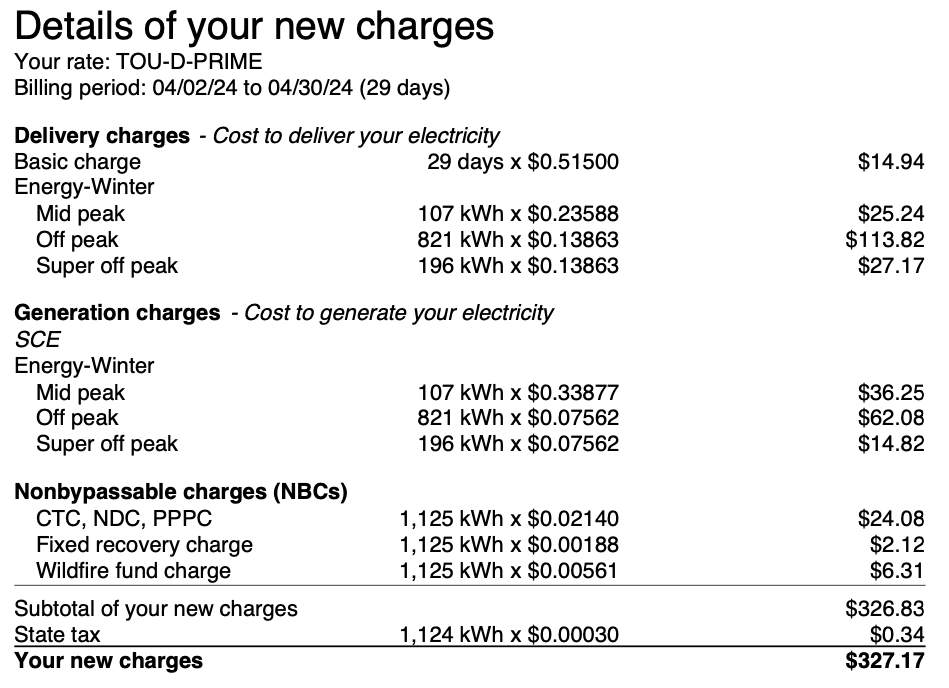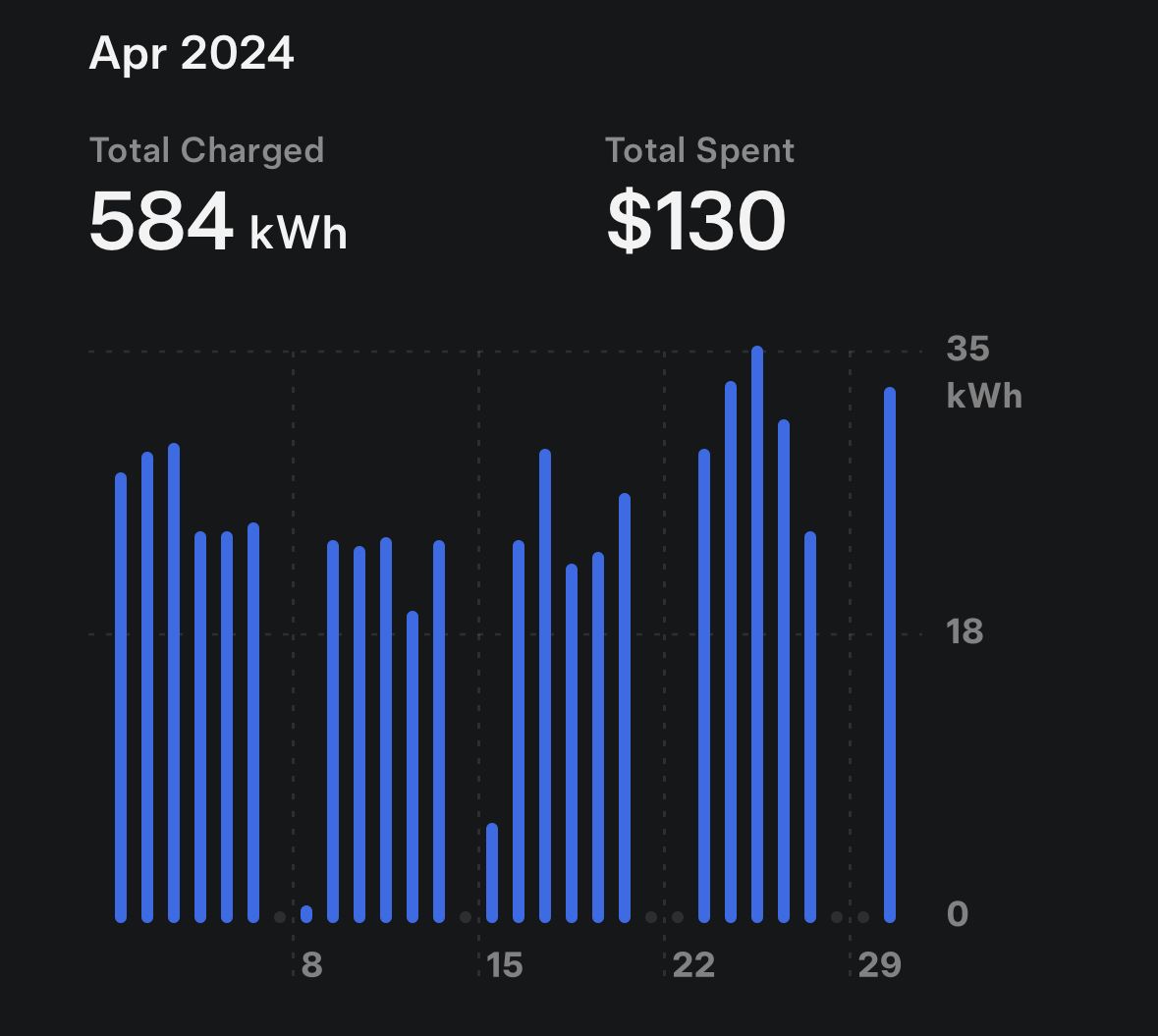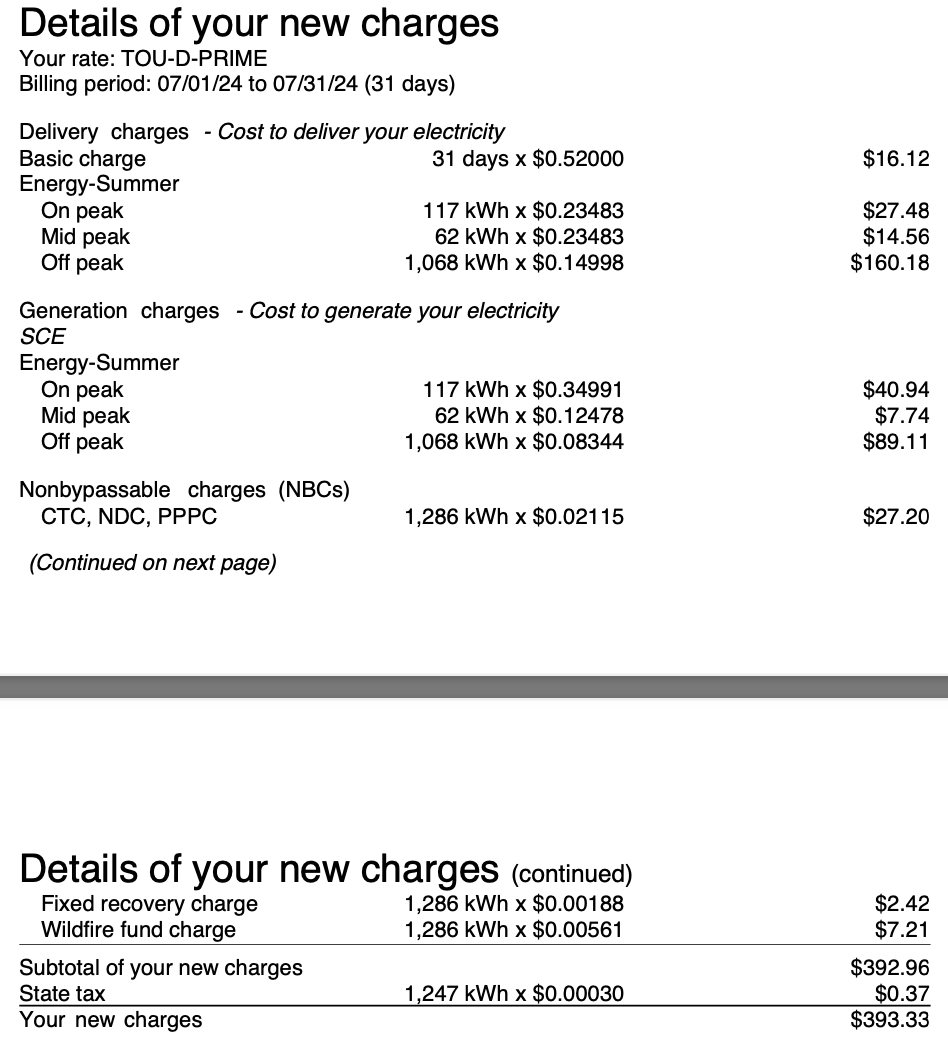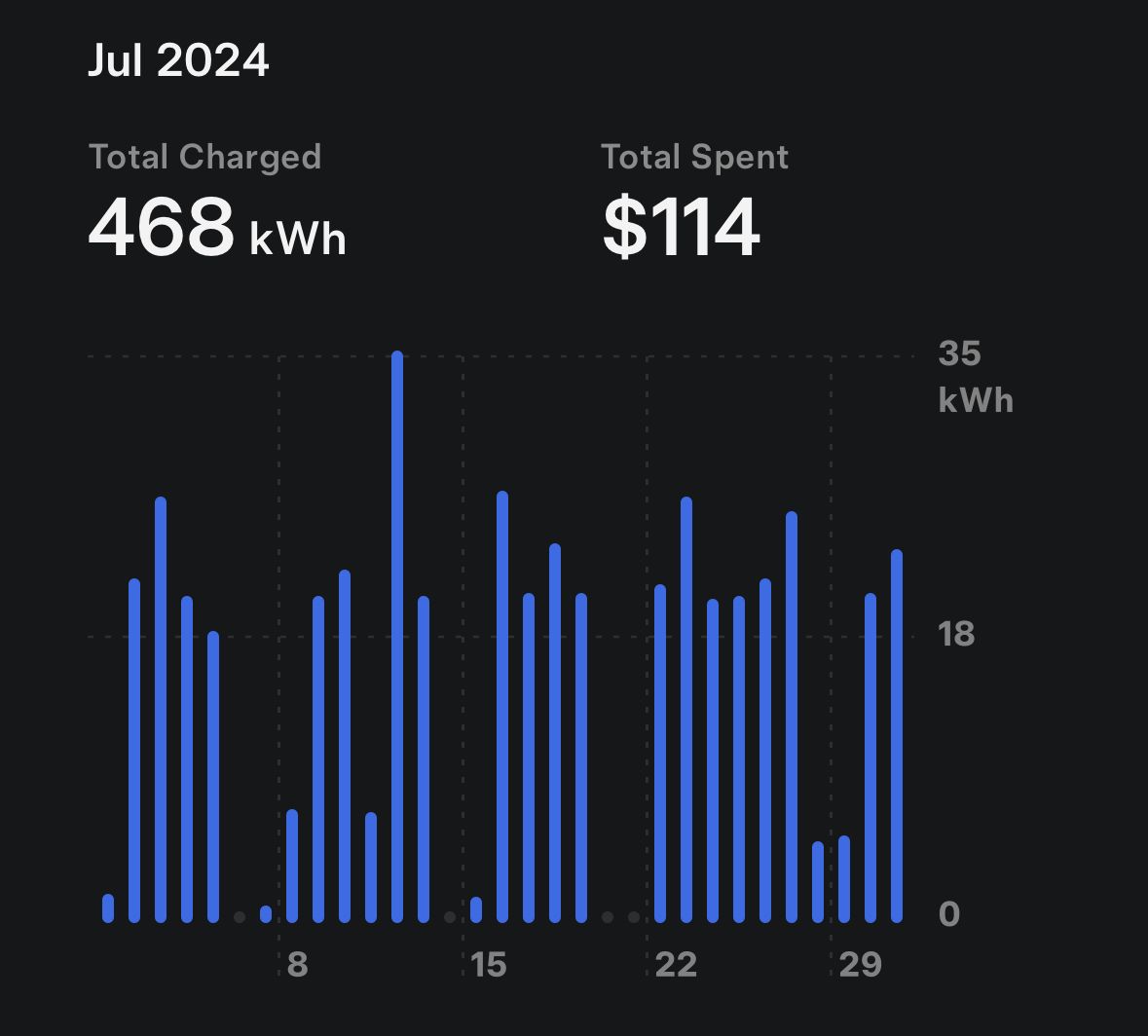Slash Your Skyrocketing Electricity Costs: My 30% Power Bill Reduction Strategy
Shocked by a $4800 annual electricity bill? Discover how I analyzed my power usage and developed a strategy to slash costs by 30%. Learn about Time-of-Use billing, the impact of peak hours, and how combining solar panels with battery storage can lead to significant savings.
Preface
Over the last twelve months, I’ve paid Southern California Edison almost a whopping $4800 on electricity used. According to research published by Energy Sage, average Californians spend about $4632 per year, which is not that far off from my number. However, I still find this rather shocking, and I believe I must take action to reduce the power bill.
Usage Analysis
First, let’s discuss how SCE charges for usage. I am on what’s termed a “Time-Of-Use”, or TOU, rate plan. Compared to the other rate plan, which is the “Tiered” plan, TOU rate plan charges differently based on the time-of-day which the usage occurred.
For example, SCE defines winter months as October 1st to May 1st, with rates as follows:
| Time of Use | Hours | Rates |
|---|---|---|
| Super Off-Peak | 8am-4pm | 23c |
| Mid Peak | 4pm-9pm | 58c |
| Off-Peak | 12am-8am, 9pm-12am | 23c |
And here’s summer, covering June through September:
| Time of Use | Hours | Rates |
|---|---|---|
| On-Peak (Weekdays Only) | 4pm - 9pm | 61c |
| Mid-Peak (Weekends Only) | 4pm - 9pm | 38c |
| Off-Peak | 12am - 4pm, 9pm - 12am | 25c |
As for the tiered plan, based on my baseline region number, I only get 19.3 kWh per day allocation for the baseline usage, costs about 33c/kWh. The next tier, which is the part that is greater than the baseline usage, would be 42c/kWh. Since I have two electric cars, Tiered rate plan would just melt through the baseline, and every bits of electricity after that would be at 42 cents per kilowatt hour, which isn’t feasible in my point of view.
If you are new to the site, then you may or may not know that I am a homelab enthusiast who loves testing servers and hardware. I have a server rack running enterprise grade gear, and some other servers I whipped up myself for their power efficiency. In my last blog post, I detailed my process for building a Proxmox cluster while staying in a power budget. So, with these server equipment running 24/7, I, inherently, used more electricity than an average household. For example. a Brocade L3 switch idles around 90-110 watts, which translates to about 2.4 kWh per day. Multiply that by thirty, it’s 72 more kilowatt hours that is needed to run that device alone. Factoring in some other servers and equipment, I believe the baseline for the whole lab will be more or less about 180 more kWh per month than an average Joe.
Here’s a look at my usage for May 2024:

According to the table listed above, my main usage occurred during off-peak hours, which makes sense, since I have my EVs to start charging just past midnight, and the time period has 19 hours in it. Now, I’m not that concerned about EV charging costs, since it is still way cheaper than gas. Based on my calculations, I spent about $130 to charge my Tesla Model 3.

So that leaves us with $197 of electricity used in the house. For that $197, it is the mid-peak that bites the hardest. For a mere 107 kWh, which is less than 4 kWh per day for the 29 days billed, I had to shell out more than $61 for it, or more than 30% of the bill less the EV charging cost.
That was in April, which is probably the nicest months in California. Sunny, the temperature hovers between 62F to 75F, with brief moments touching 80F but cools down quickly in the evening, so there’s virtually no cooling cost other than a fan or two running to circulate the air.
Now, let’s take a look at July, which had multiple scorching hot days above 100F, and I was billed for summer rates:

Again, let’s take out the EV charging part, which was $114 for the month of July.

That leaves us with a bill of $279. Again, let’s take a look at the usage. According to the table above, both On-Peak and Mid-Peak are more expensive, but the times of day are the same, which is from 4pm to 9pm - the hottest hours that I need to run my AC. The cost sums up to about $90 paid for electricity used, or 32% of my bill with the EV charging portion taken out.
What-If?
See, those peak hour rates of 61c/kWh in summer and 58c/kWh in winter really bite. I can’t just shut the main breaker down during those hours and leave my family without power just to save a Benjamin, so what can I do?
Avoid Using High Power Appliances
My only “high power appliances” used during peak hours are microwave and air fryer. The range, oven, water heater, oven and furnace run on natural gas. I do watch TV and use the Internet like a normal person, but other than that, there’s very little use of other high powered stuff, other than the AC.
Pre-Cooling
I’ve tried it, but it is not very effective. The concept of pre-cooling is that you will run your AC to a temperature as low as you can comfortably live in, and turn the AC off during peak hours. In California, this really doesn’t work, at least for my property. I tried running my 4.5 Ton AC full tilt for two hours up to peak hours, and the temperature quickly rose from 72F to 82F in the span of, you’ve guessed it, two hours. Since the peak hours starts at 4pm, by the time everyone got home at 6pm, the house is just as hot as if there’s no AC at all.
Load-Shedding
Simply put, turn stuff off. Now, I consider my server rack to be the biggest enemy of this approach. But, I have plans to move the entire rack to solar power. By then, the rack will be on a battery with an inverter and a solar charge controller hooked up to it, so I don’t have to worry about on-peak usage anymore.
Peak-Shaving
This is the most interesting method for reducing peak hour usage. Basically, you'll need an Energy Storage System (ESS) to store electricity when prices are low. This stored energy can then be used when prices are high. For lack of better words, you will need a big battery, a big enough inverter for your house, and some ways to recharge the battery when it is depleted. For example, I can use a server rack Lithium Iron Phosphate battery that runs at 48V, hook it up to an inverter like the EG4 6000XP, and connect it with an array of solar panels, as well as the power grid. When the peak hour comes, I will program the inverter to only draw power from the battery, which should be charged by the solar panels during the day, to provide power to the house without drawing from the grid. When the battery gets low, the inverter would also switch back to grid power to continue provide power to the house.
This is a solution I have great interest in. First of all, California is almost as good as it gets when it comes to solar resources. I could just put up a few panels, then my on-peak power usage would be mostly covered. Of course, a small battery won’t be able to run my 4.5 ton AC for long, but that can still be beneficial for offsetting most of the usage.
The Plan
According to my calculation, on average, I use about 4 kWh during those hours, and the max number I have was 6.2kWh. If I want to oversize it for some headroom, I think I can get by with 10kWh of battery storage.
To charge these batteries, I’d need solar panels. With this nice calculator from NREL, I found out that with a 2.4kW solar array, even during the lowest production month of December, I can still get an average of 5.5 kWh per day, while I only used an average of 4.3 kWh per day on-peak back in last December.
The Cost
So, it all sounds roses and sunshine at this point. But how much would an ESS that capable of what I just described cost?
First of all, I’d need 10kWh worth of batteries. I’ve seen good reviews for the EG4 LifePOWER4 48V 100Ah batteries. It provides 4.8kWh of energy storage, so I’ll need two. The going price is $1199 per unit, so $2400 on this front.
Then, I will need solar panels. For a 2.4kW system, it is either a) 6 panels, 400W each, or b) 7 panels, 350W each, and c) 4 panels, 600W each. Very few online solar shops would sell you less than 10 panels, so from what I’ve gathered on local Facebook Marketplace, it costs about $500-1050 just to get my desired size.
Furthermore, I will need an inverter to convert DC battery power to AC, and a way to recharge these batteries when they are empty. Luckily, EG4 comes to the rescue again. Their EG4 6000XP all-in-one inverter both takes energy out and puts energy back to the batteries, and this device costs $1399.
Last but not least, some cables, hardwares, and new breakers. I will just put another $800 in this category.
To sum it up:
| Category | Product | Price |
|---|---|---|
| Batteries | EG4 LifePOWER4 x 2 | $2398 |
| Solar Panels | Varies between diff. conf. | $900 |
| Inverter | EG4 6000XP | $1399 |
| Misc. Hardware | Mounts, Cables, Breakers | $800 |
| Total | $5497 |
If I buy everything with the prices listed above, this system is going to cost $5500. But, remember that on-peak usage accounts for 30% of my bill? For the $4800 I paid, by deploying an ESS, I can take 30% off my electricity bill, which is about $1440 per year. With this number, the cost of the ESS system will be recouped in 4 years. The batteries and the inverter both have 10 year warranties, and the solar panels are often rated for 85% original capacity at 20 years, so a 4 year ROI is well within the acceptable range. Furthermore, cost of electricity is only going to go up from here, so in reality, the ROI could be well under 4 years.
Conclusion
In this deep dive into my electricity usage and costs, we've uncovered some startling realities:
My annual power bill of nearly $4800 aligns closely with the California average, but it's still a significant expense.
Time-of-Use billing significantly impacts costs, with peak hours (4pm-9pm) accounting for about 30% of my bill despite lower usage.
Even with two electric vehicles and a home lab, there's room for substantial savings.
The proposed Energy Storage System (ESS) solution, combining solar panels and battery storage, offers a promising path forward:
Estimated cost: $5500
Potential annual savings: $1440 (30% of current bill)
Expected ROI: 4 years, or less (if SCE hikes prices again)
This investment not only makes financial sense but also increases energy independence and reduces reliance on the grid during peak hours. As electricity costs only going to continue to rise, the benefits of such a system will likely grow.
Looking ahead, this project represents more than just cost savings. It's a step towards a more sustainable and efficient home energy system. By taking control of our energy consumption and production, we're not just reducing bills – we're participating in the broader shift towards smarter, cleaner energy use.
Whether you're a fellow tech enthusiast, a homeowner looking to cut costs, or someone interested in sustainable living, I hope this analysis provides valuable insights for your own energy-saving journey. Stay tuned for updates as I implement this system and track the real-world results!